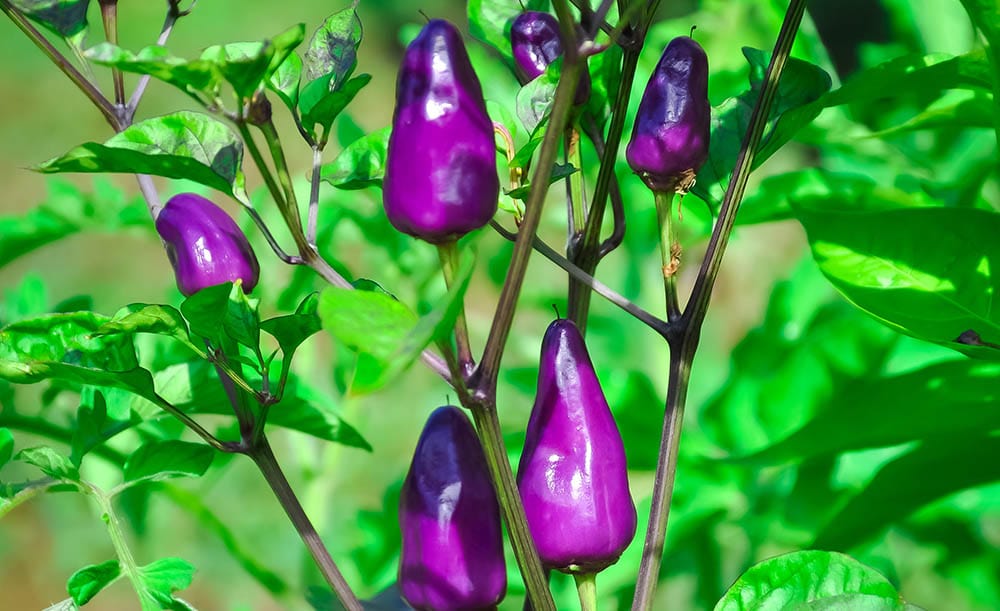7 Types of Jalapenos (With Pictures)
-
Codee Chessher
- Last updated:

Jalapeno peppers are one of the most widely eaten chilies on the planet, with a relatively low heat level and an instantly recognizable flavor. Most of us are probably familiar with the green and occasional red jalapeno, but not the fact that there are numerous types of jalapenos. With a huge range of colors, shapes, and heat levels, there are tons of jalapenos you can go hunting for on your next grocery run. Let’s check out a few and what they’re like.

The 7 Types of Jalapenos
1. Lemon Spice Jalapeno
| Size: | 2”–3” long |
| Scoville heat level: | 2,500–5,000 (medium) |
Developed by New Mexico State University, this brightly colored pepper grows larger than a typical jalapeno and grows to a rather large size. They first turn green, then briefly remain yellow for harvest, and finally turn red if left unpicked. They’re surprisingly hot, but the flavor is distinctly fruit-like. The heat, flavor, and color make it a spicy competitor to bell peppers for salads and other dishes.
2. Purple Jalapeno

| Size: | 3”–5” long |
| Scoville heat level: | 2,500–8,000 (medium) |
Purple jalapenos look quite impressive while growing, producing striking purple and black flowers. In the kitchen, they’re not that special, though, with the same flavor profile and heat level of a regular jalapeno pepper. Because some of them take longer to ripen on the vine, larger purple jalapenos might lean toward more heat. They give some unique color to salads, with thick walls that make them easy to slice.
3. Mammoth Jalapeno

| Size: | 5” long |
| Scoville heat level: | 1,000–5,000 (mild) |
Growing to a prodigious size and up to 2 inches in diameter, you might expect mammoth jalapenos to take the crown as heat king. However, they rarely produce more than 5,000 Scoville units, which is about par for a moderately spicy jalapeno. The large size of this pepper makes it ideal for stuffing and pickling. In the garden, they are disease-resistant and grow in about 75 days.
4. Jalafuego Jalapeno
| Size: | 3”–4” long |
| Scoville heat level: | 4,000–8,000 |
Also called Fuego after the Spanish name for fire, this is one of the spiciest jalapenos available. It consistently offers high heat levels for a jalapeno, although not by a lot. Most specimens are 3–4 inches long, but some can grow up to 6 inches long and as big as a mammoth jalapeno. This pepper is prized for its heat, making it perfect for sauces and soups. If you’re more adventurous, they’re great in nearly everything else too.
5. Black Jalapeno
| Size: | 3”–3.5” long |
| Scoville heat level: | 2,500–10,000 |
Black jalapenos start out like regular jalapenos: ripening to a green color. However, these are unique in that they turn black with more sun exposure. Most growers give them as much sun as possible to encourage a fully black appearance, but in a garden, they’ll merely gain a black blush. When harvested early, black jalapenos can be sweet and juicy. When left on the vine for longer, they can get extremely spicy.
6. Jaloro Jalapeno
| Size: | 3” long |
| Scoville heat level: | 2,500–8,000 |
Sometimes called the yellow jalapeno pepper, the jaloro was developed by the Texas Agriculture Extension in the 1990s. You can eat them at any stage, but they’re typically picked when they’re yellow and sweet. If left on the vine for longer, they turn a spicier bright red that’s comparable with a regular jalapeno. These get pretty big, so they’re great for pickling, too.
7. Mucho Nacho Jalapeno

| Size: | 4” long |
| Scoville heat level: | 2,500–8,000 |
These are hard to tell apart from regular jalapenos, but the key is that they’re much larger, growing up to 4 inches long. They’re also very wide, which makes them great for jalapeno poppers. They veer toward the spicy end of the spectrum, averaging 8,000 on the Scoville heat scale. If left on the vine, they’ll turn a delicious red color.

Final Thoughts
Jalapenos are one of the most delicious ways to spice up a meal or snack, but who knew there were so many different types? From the dangerous black jalapeno to the relatively mild jaloro jalapeno, there’s something on this list for you to try.
Featured Image Credit: GregReese, Pixabay
Contents